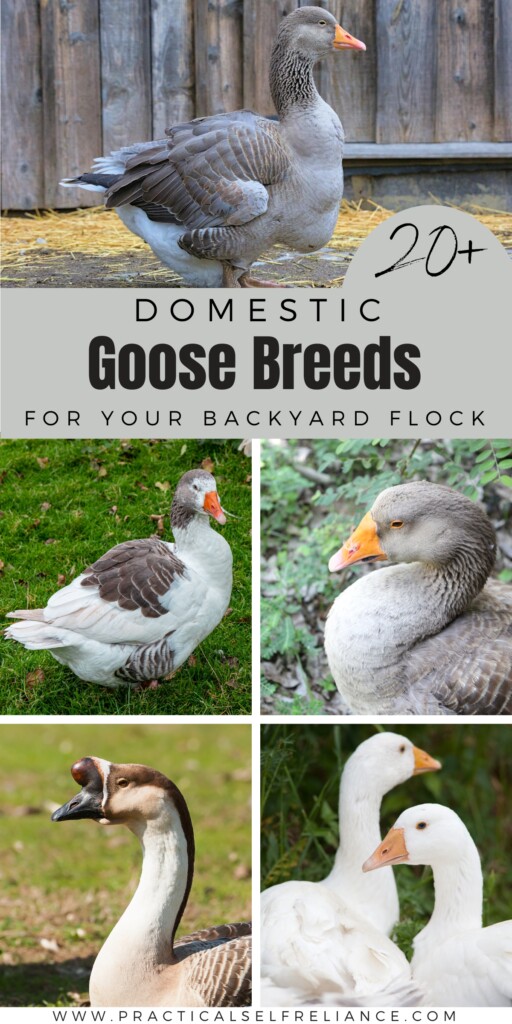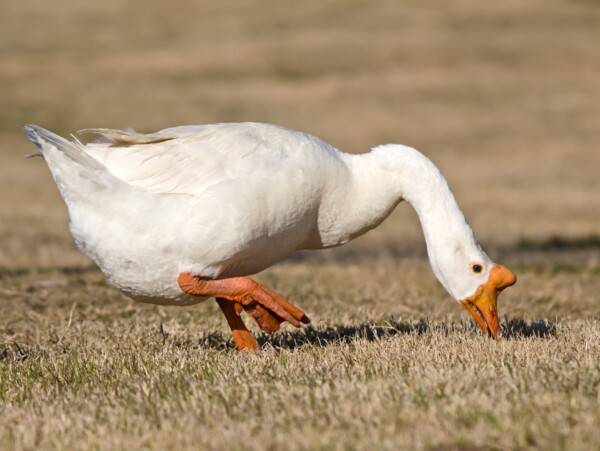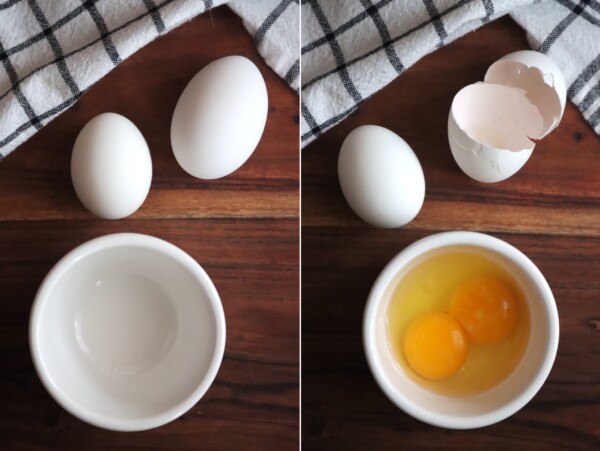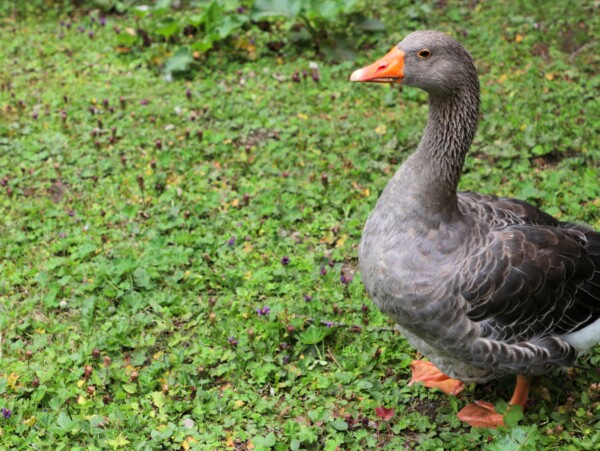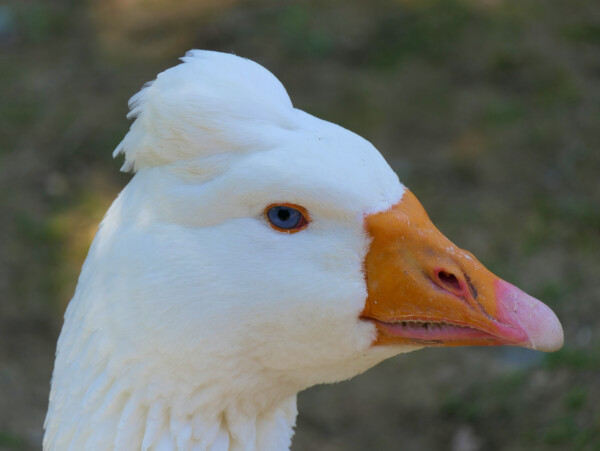Affiliate disclosure: This post may contain affiliate links. Please see our Privacy Policy.
Goose breeds can be confusing, especially if you’re new to keeping geese. Whether you’re raising them for meat, eggs, pasture weeding, or just because they make excellent watch animals, choosing the right goose breed is key to success on the homestead.
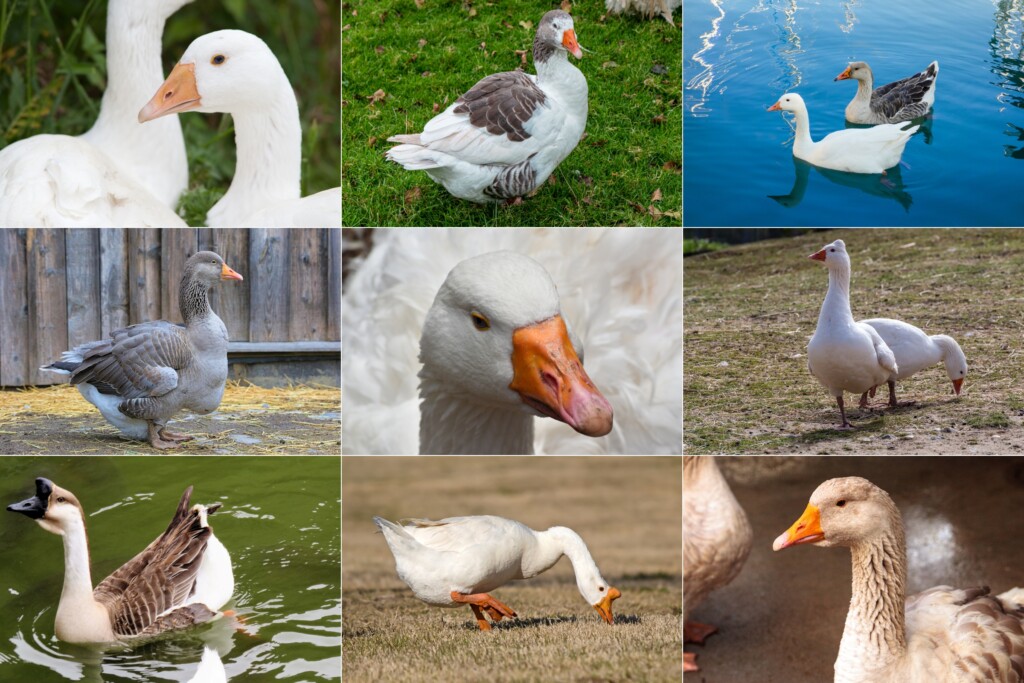
Table of Contents
- Choosing a Goose Breed
- Breed Purpose
- Temperament
- Size
- Foraging Ability
- Egg Production
- Lifespan and Reproductive Longevity
- Feathering and Weather Hardiness
- Autosexing Geese
- List of Goose Breeds
- African Goose
- American Buff Goose
- Brecon Buff Goose
- Buff Back Goose
- Chinese Goose
- Cotton Patch Goose
- Czech Goose
- Embden Goose
- Landes Goose
- Normandy Goose
- Oland Goose
- Pilgrim Goose
- Pomeranian Goose
- Roman Goose
- Sebastopol Goose
- Shetland Goose
- Steinbacher Goose
- Toulouse Goose
- Tufted Buff Goose
- West of England Goose
When we first started raising geese, we had no idea how many options there were. Our local feed store had just one generic “white gosling” bin each spring—and the birds that grew out of it were noisy, fast-growing, and surprisingly friendly. It wasn’t until later that we figured out they were likely Embdens, the most common white goose in North America.
Back then, I didn’t realize that was only scratching the surface. In the US, most hatcheries carry 4 to 7 goose breeds, including:
- African
- American Buff
- Embden
- Pilgrim
- Roman (& Tufted Roman)
- Sebastopol
- Toulouse
That said, you can sometimes find specialty goose breeds from smaller hatcheries and backyard breeders, provided you know to seek out those breeds. That’s why I did a bit of research and compiled this more exhaustive list of goose breeds to get you started.
There are dozens of domestic goose breeds worldwide, from compact ornamental types to hefty meat birds and everything in between. Some are calm and family-friendly, while others are better suited to large pastures and perimeter guarding.
If you’ve ever wondered which goose breed is best for your climate, goals, and space, this guide breaks it all down to help you make an informed choice.

Choosing a Goose Breed
Selecting the right goose breed involves more than just deciding between meat or eggs. While geese are often lumped together as big, noisy pasture birds, each breed has unique characteristics that influence how they’ll fit into your homestead or backyard setup.
Here are a few key traits to keep in mind as you read through the breed profiles.
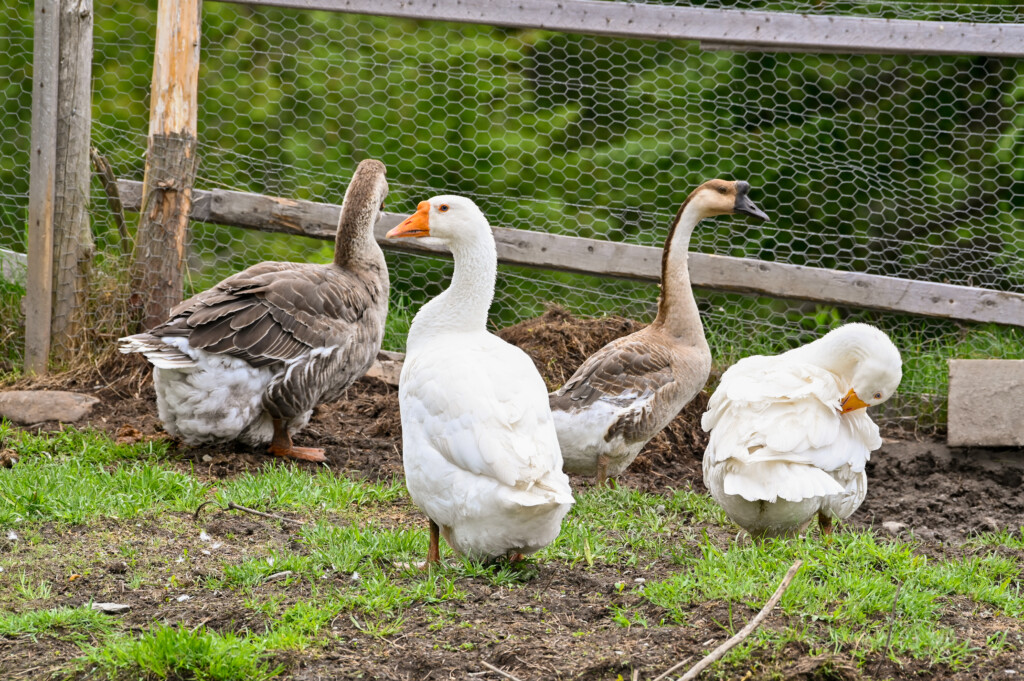
Breed Purpose
Meat Breeds – These are the big, heavy geese bred for their size and carcass quality. They grow fast and yield tender meat but may be less agile foragers or less prolific layers. Embden and African geese are classic meat breeds.
Egg-Laying Breeds – While all geese lay eggs, some breeds are more prolific than others. Chinese geese top the charts, often laying 40–60 eggs per year, while other breeds may only lay a couple dozen each spring.
Dual-Purpose Breeds – These geese offer a good balance of meat and egg production, often with calmer temperaments and decent foraging skills. American Buffs and Pilgrims are great examples.
Ornamental Breeds – Known more for their appearance than utility, these geese are often kept for show or as pets. Sebastopols, with their curly feathers, and tufted Romans fit this category.
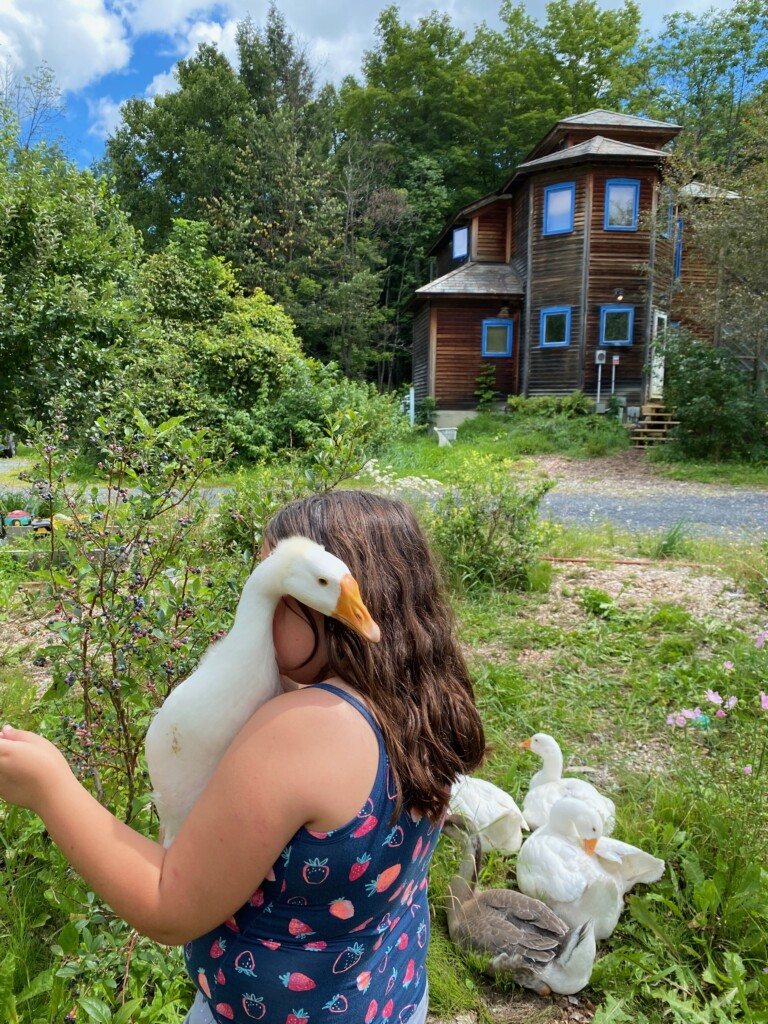
Temperament
Do you want calm, friendly birds your kids can help feed, or alert honkers that patrol your yard like feathered watchdogs?
Some breeds are famously docile (like Buff or Pilgrim geese), while others (like Chinese and African geese) are far more vocal and territorial—especially during the breeding season.
Raising geese from goslings and handling them frequently helps improve temperament, regardless of breed, but certain breeds are naturally more laid-back than others.
Size
Geese come in a wide range of sizes, from lightweight 8-pound Chinese geese to 25+ pound Embdens. Body size influences everything from housing space to feed consumption and flight risk.
- Lightweight Breeds – These are active, slender geese that do well on pasture and are more agile. They’re also the most vocal. (Think Chinese geese.)
- Medium Breeds – Often the best for small homesteads, these geese offer a balance of productivity, manageability, and calm temperament. (Buff, Pilgrim, Roman.)
- Heavyweight Breeds – These are the meat giants. They’re impressive birds but need more space, feed, and weather protection. (Embden, African, Toulouse.)
All of them start about the same size as goslings, but this cute little fluffball stage wont last long. Most geese are fully feathered and nearly full size by 8 to 10 weeks.
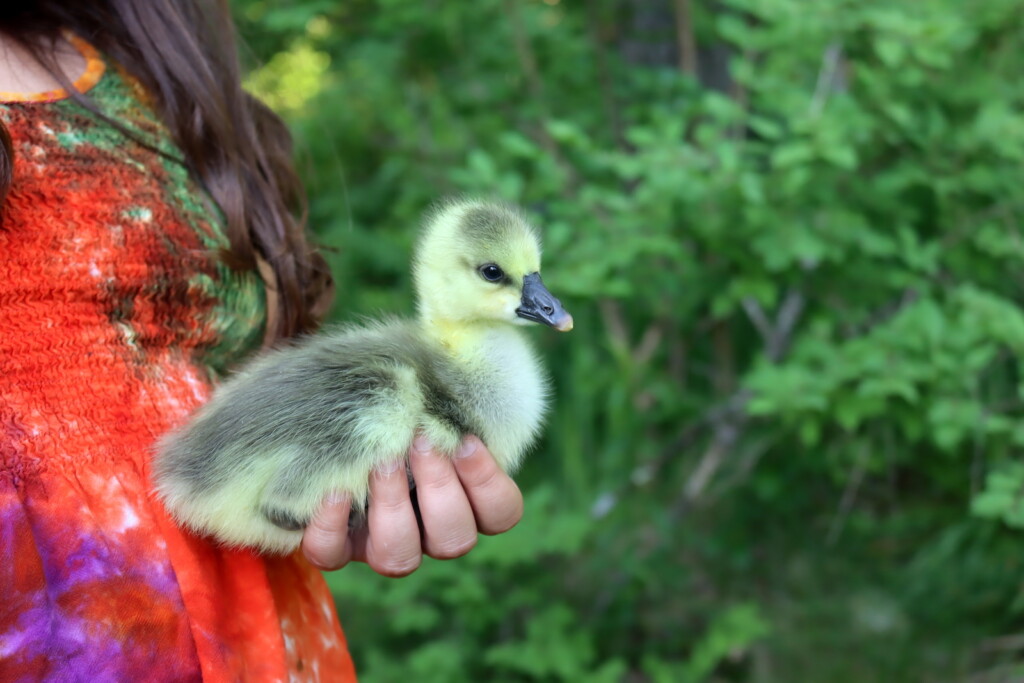
Foraging Ability
Most goose breeds are good grazers, but lighter-bodied breeds tend to forage better and cover more ground without damaging tender plants. Heavier breeds may do better in pasture-only settings rather than gardens.
If you’re hoping to use geese for natural weeding (especially in row crops or orchards), go for Chinese or Roman geese. They’re nimble, active, and very efficient at clearing grass and broadleaf weeds.
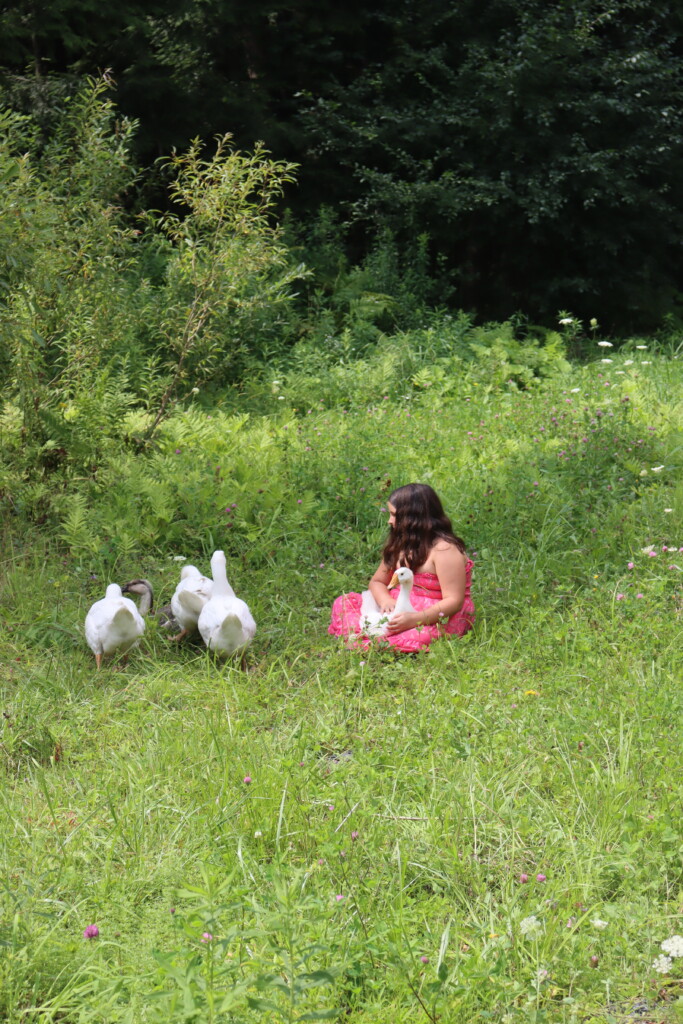
Egg Production
Geese don’t lay year-round like chickens. Most breeds lay in the spring only, usually between 15 and 40 eggs per season.
Chinese geese are the best layers, followed by Tufted Romans and American Buffs. If eggs are a primary goal, steer clear of purely ornamental or heavy meat breeds like Dewlap Toulouse, which may lay just 10–15 eggs a year.
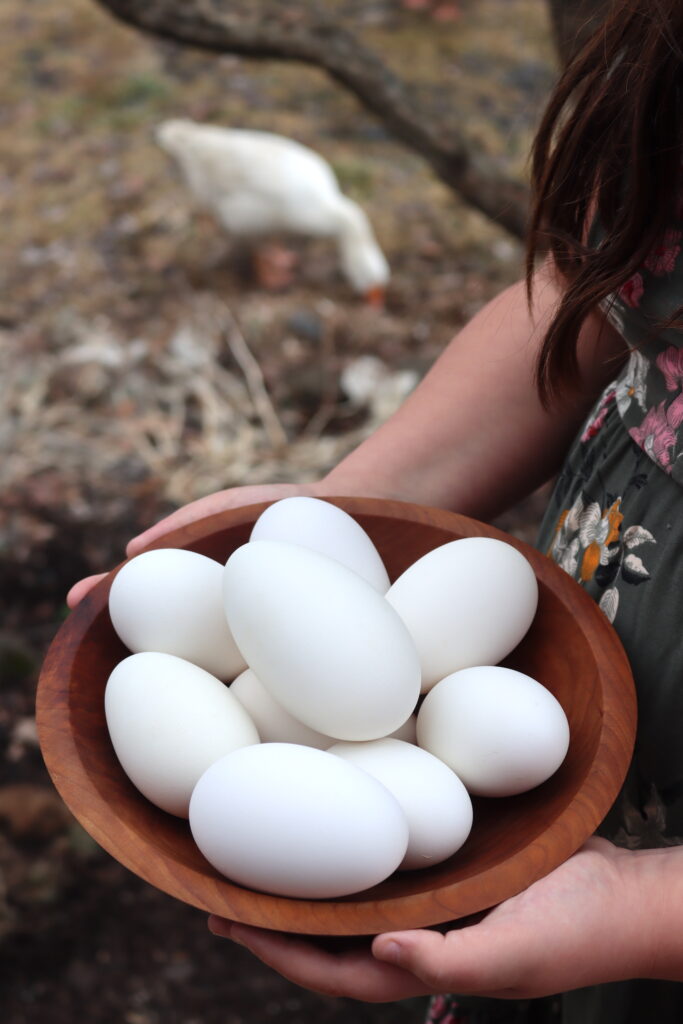
Lifespan and Reproductive Longevity
Geese are long-lived birds, often reaching 15 to 20 years with good care. That said, their most productive years for egg-laying or hatching are generally from ages 2 to 7.
Unlike chickens, many geese won’t begin laying until their second spring—especially larger or slower-maturing breeds. Some geese remain productive much longer than others, especially heritage breeds that haven’t been bred for rapid growth.
Feathering and Weather Hardiness
Almost all goose breeds are naturally cold-hardy, thanks to their thick down and insulating feathers. However, some breeds—especially those with ornamental features like Sebastopols or large dewlaps—may need extra care in wet, cold weather.
If you’re in a very hot climate, consider a lighter-bodied breed that handles heat better, such as Chinese or Roman geese. Heavier breeds are more prone to heat stress.
Autosexing Geese
Some goose breeds are autosexing, meaning you can tell males from females by their coloring as soon as they hatch or once they feather out. This trait is most notable in Pilgrim geese, where ganders are mostly white and females are gray. Cotton patch, West of England and Normandy geese are also auto sexing.
It’s a helpful feature for small-scale breeders and backyard keepers who want to maintain a balanced flock without guesswork. While not many goose breeds are autosexing, those that are make early flock management much simpler—especially if you’re planning for breeding, meat production, or avoiding extra males.
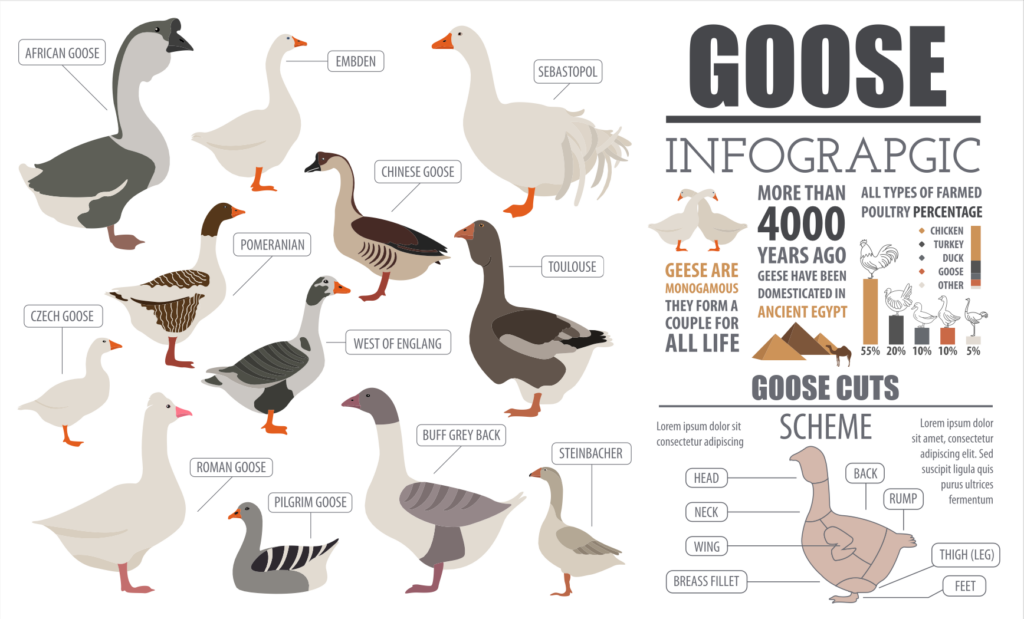
List of Goose Breeds
This A to Z list of domestic goose breeds includes all the common (and not-so-common) geese kept for eggs, meat, foraging, and companionship. Each profile includes temperament, productivity, hardiness, and other key traits.
Some are pure heritage breeds that reproduce naturally, while others are hybrids or modern production strains.
I’ll take you through each breed one by one, but this table summarizes their main characteristics:
| Breed | Type | Temperament | Weight (Gander) | Eggs/Year | Egg Color | Cold/Heat Hardiness | Foraging Ability |
|---|---|---|---|---|---|---|---|
| African | Heavy | Calm, protective | 20–25+ lbs | 20–40 | White | Very Cold Hardy | Good |
| American Buff | Dual-purpose | Docile, calm | 18–20 lbs | 15–35 | White | Cold Hardy | Excellent |
| Brecon Buff | Dual-purpose | Calm, alert | 18–20 lbs | 20–30 | White | Cold Hardy | Excellent |
| Buff Back | Dual-purpose | Calm, pasture-adapted | 16–18 lbs | 20–30 | White | Cold Hardy | Good |
| Chinese | Egg-laying/Guard | Vocal, alert | 10–12 lbs | 50–100 | White | Heat Tolerant | Excellent |
| Cotton Patch | Heritage, egg-laying | Calm, intelligent | 10–12 lbs | 20–40 | White | Heat Tolerant | Exceptional |
| Czech | Dual-purpose | Active, independent | 12–14 lbs | 25–35 | White | Very Cold Hardy | Excellent |
| Embden | Meat | Calm, strong | 25–30 lbs | 20–40 | White | Cold Hardy | Good |
| Landes | Meat/foie gras | Active, calm | 18–20 lbs | 20–30 | White | Cold Hardy | Good |
| Normandy | Dual-purpose | Quiet, adaptable | 16–18 lbs | 25–35 | White | Cold Hardy | Excellent |
| Oland | Heritage | Hardy, independent | 10–12 lbs | 20–30 | White | Extremely Cold Hardy | Exceptional |
| Pilgrim | Dual-purpose | Friendly, calm | 14–16 lbs | 25–45 | White | Cold Hardy | Excellent |
| Pomeranian | Dual-purpose | Hardy, assertive | 16–18 lbs | 20–35 | White | Very Cold Hardy | Excellent |
| Roman | Ornamental | Friendly, alert | 10–12 lbs | 25–35 | White | Cold Hardy | Good |
| Sebastopol | Ornamental | Gentle, friendly | 12–14 lbs | 20–30 | White | Cold Hardy (Not Waterproof) | Moderate |
| Shetland | Heritage | Hardy, low-maintenance | 12–14 lbs | 20–30 | White | Extremely Cold Hardy | Excellent |
| Steinbacher | Ornamental | Alert, intelligent | 12–14 lbs | 20–30 | White | Very Cold Hardy | Excellent |
| Toulouse | Meat | Gentle, quiet | 20–26 lbs | 20–35 | White | Cold Hardy | Moderate |
| Tufted Buff | Ornamental | Friendly, calm | 16–18 lbs | 20–30 | White | Cold Hardy | Good |
| West of England | Dual-purpose | Calm, easygoing | 16–18 lbs | 20–30 | White | Cold Hardy | Very Good |
African Goose
The African goose is a large, stately bird with a deep honk, a massive body, and a prominent dewlap and knob. Though they’re descended from the same wild swan goose as Chinese geese, they’re much heavier, quieter, and calmer.
African geese are primarily raised for meat, but they’re also excellent guard animals thanks to their imposing size and strong flock instincts. They’re cold-hardy but need protection from extreme heat, especially in humid regions.
Despite their size, they can become quite friendly with regular handling and do well on pasture with minimal supplemental feed.
- Breed Name: African
- Breed Type: Meat, guardian
- Temperament: Calm, alert, protective
- Size: Ganders 20–25+ lbs, Geese 16–20 lbs
- Eggs Per Year: 20–40
- Egg Size: Very large
- Egg Color: White
- Hardiness: Cold hardy, heat sensitive
- Foraging Ability: Good
- Lifespan: 15–25 years
- Time to Maturity: 26–32 weeks
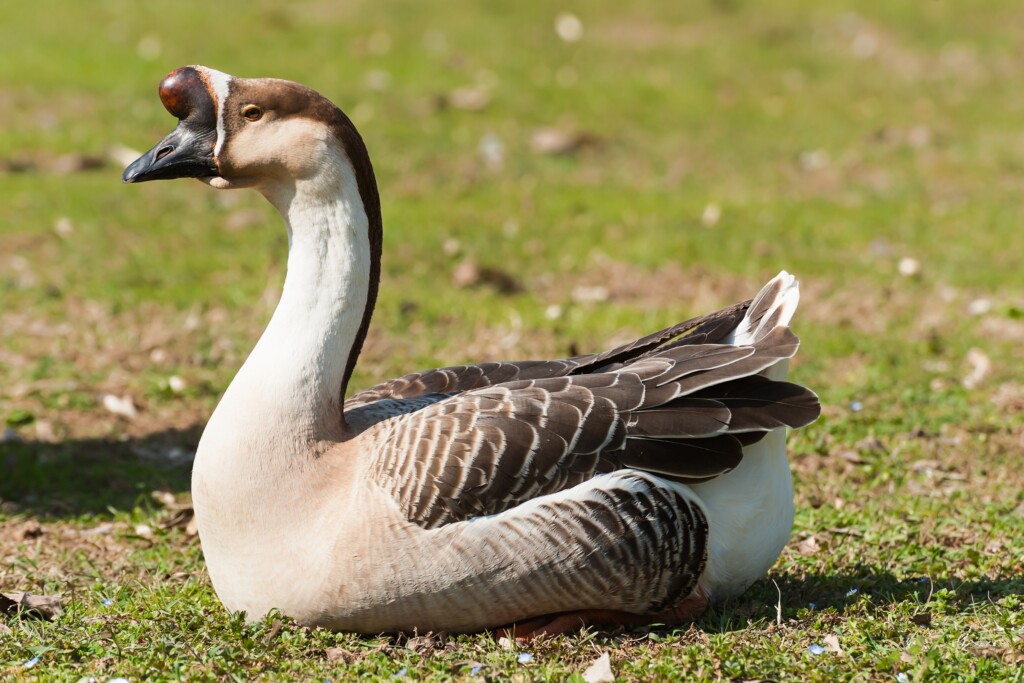
American Buff Goose
American Buff geese are one of the few goose breeds developed in the United States, making them a true heritage bird with deep homesteading roots. They’re instantly recognizable by their soft apricot-buff coloring, pale underbellies, and gentle expressions. Compared to some of the more upright or heavily muscled goose breeds, American Buffs have a rounded, balanced build and an easygoing presence in the yard. Their calm demeanor, manageable size, and attractive appearance have made them a favorite among backyard keepers and family farms alike.
This breed is especially prized for its temperament. American Buff geese are widely known for being docile, curious, and friendly—even with children or inexperienced handlers. They’re excellent foragers and thrive on open pasture, requiring less supplemental feed than many other breeds during the growing season. Though not as vocal as Chinese or African geese, they will still alert the flock to intruders or unusual activity, making them a good choice for low-drama guarding. With regular handling from a young age, they can become affectionate and even follow you around the yard.
While they’re not the largest meat breed, American Buffs are still a solid dual-purpose choice. They produce a good carcass at harvest size and lay 15 to 35 large, white eggs each spring. Hens often go broody and are known to be attentive, reliable mothers. Their ability to raise goslings naturally makes them a good choice for closed-flock breeding. Cold-hardy, pasture-adapted, and mellow by nature, American Buff geese are an ideal choice for small homesteads or anyone raising geese for the first time.
- Breed Name: American Buff
- Breed Type: Dual-purpose (meat and eggs)
- Temperament: Calm, docile, good with families
- Size: Ganders 18–20 lbs, Geese 15–18 lbs
- Eggs Per Year: 15–35
- Egg Size: Very large
- Egg Color: White
- Hardiness: Cold hardy, pasture adapted
- Foraging Ability: Excellent
- Lifespan: 12–20 years
- Time to Maturity: 24–30 weeks
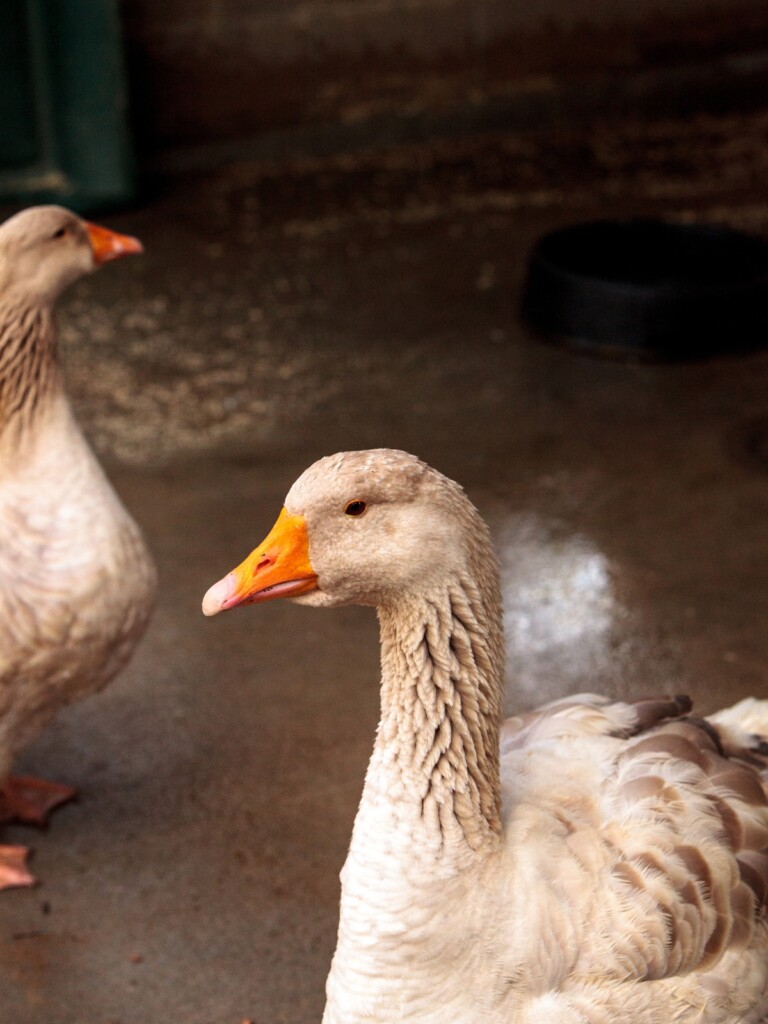
Brecon Buff Goose
The Brecon Buff goose is a rare heritage breed developed in Wales and named after the Brecon Beacons region. Though similar in appearance to the American Buff, the Brecon Buff is slightly more compact, with a warm buff coloring, pinkish legs, and a pink bill rather than orange. This breed was developed in the early 20th century and is valued for its productivity and adaptability to small farm environments, especially in wet, cool climates.
Brecon Buffs are known for being hardy and self-reliant birds that thrive on forage. They’re excellent grazers and are well suited to rotational grazing systems or free-ranging in mixed-species pastures. Their calm disposition makes them manageable for small flock keepers, and they integrate well into mixed flocks with other poultry. They are especially well-regarded in the UK and Europe but are still relatively rare in North America.
This breed lays between 20 and 30 large white eggs each spring and has decent meat quality for its size. Brecon Buff geese are also capable of raising their own goslings, though individual hens vary in broodiness. Their manageable size, cold weather resilience, and friendly nature make them an excellent breed for homesteaders looking for both form and function in their geese.
- Breed Name: Brecon Buff
- Breed Type: Dual-purpose
- Temperament: Calm, alert, and good foragers
- Size: Ganders 18–20 lbs, Geese 16–18 lbs
- Eggs Per Year: 20–30
- Egg Size: Large
- Egg Color: White
- Hardiness: Cold hardy, damp climate tolerant
- Foraging Ability: Excellent
- Lifespan: 12–15 years
- Time to Maturity: 24–28 weeks
Buff Back Goose
The Buff Back goose, sometimes called the Greyback, is a traditional European breed developed for utility on small homesteads. With a buff-colored saddle over clean white plumage, it has a refined, upright carriage and an elegant appearance in the field. Though often overshadowed by more common breeds like the American Buff or Embden, the Buff Back holds its own as a practical, dual-purpose goose with a bit of extra visual flair.
This breed is medium-sized, with ganders weighing around 16–18 pounds and geese a few pounds less. Buff Backs are calm, manageable birds that do well in mixed flocks and adapt readily to free-range or small pasture settings. They’re especially good for rotational grazing setups and are efficient at keeping grass and weeds trimmed down in orchard or garden margins.
Egg production typically falls between 20 and 30 eggs per year, and while not all hens will go broody, those that do are capable mothers. Buff Backs are known for good fertility and hatch rates, making them a favorite among heritage breed keepers. Their steady temperament and tidy appearance make them a practical and attractive addition to the homestead.
- Breed Name: Buff Back
- Breed Type: Dual-purpose
- Temperament: Calm, easygoing, pasture-adapted
- Size: Ganders 16–18 lbs, Geese 14–16 lbs
- Eggs Per Year: 20–30
- Egg Size: Large
- Egg Color: White
- Hardiness: Cold hardy
- Foraging Ability: Good
- Lifespan: 12–15 years
- Time to Maturity: 24–28 weeks
Chinese Goose
The Chinese goose is one of the most easily recognized domestic goose breeds, thanks to its upright posture, long slender neck, and the prominent basal knob at the top of its beak. It comes in two color varieties—white and brown—but both share the same genetics and traits. Chinese geese are descended from the wild Swan Goose (Anser cygnoides), unlike most other domestic breeds that come from the Greylag Goose lineage. They’re highly active, vocal, and expressive, making them a favorite for guarding and ornamental purposes.
What really sets Chinese geese apart is their prolific egg-laying. Most domestic geese lay 20 to 40 eggs per year, but Chinese geese routinely lay 50 to 70, with exceptional hens laying over 100 in a season. Their alert, talkative nature makes them excellent watchdogs for barnyards and flocks, though they can be a bit too noisy for small urban or suburban settings. When hand-raised, they can be friendly and personable, though they are often more aloof than heavier breeds.
Chinese geese are among the best breeds for weeding and foraging. Their slim bodies allow them to navigate tight garden rows without trampling plants, and their grazing preferences tend to favor grasses and weeds over vegetables. They’re also quick-maturing and heat tolerant, making them a strong choice for warmer climates or large-scale pastured goose systems.
- Breed Name: Chinese
- Breed Type: Egg-laying, ornamental, guard
- Temperament: Active, vocal, alert
- Size: Ganders 10–12 lbs, Geese 8–10 lbs
- Eggs Per Year: 50–100
- Egg Size: Large
- Egg Color: White
- Hardiness: Heat tolerant, less cold-hardy
- Foraging Ability: Excellent
- Lifespan: 10–15 years
- Time to Maturity: 20–26 weeks
Cotton Patch Goose
The Cotton Patch goose is a rare American heritage breed that was once common throughout the southeastern United States. Named for its historic role in weeding cotton fields, this lightweight breed is uniquely suited to hot, humid climates and excels as a natural weeder. Males are mostly white with gray backs, while females are saddleback gray—making this one of the few auto-sexing goose breeds in the world.
Cotton Patch geese are calm, intelligent, and excellent foragers. They require very little supplemental feed during the growing season and are capable of clearing pasture and garden rows of broadleaf weeds and grasses without damaging crops. They also retain a strong flocking instinct, which makes them easier to manage than some more independent breeds. Though not especially vocal, they are alert and will raise the alarm if something is amiss.
This breed is critically endangered, with only a handful of breeding flocks remaining, but it is steadily making a comeback thanks to efforts by small-scale farmers and conservation breeders. Cotton Patch geese typically lay 20 to 40 eggs per year and are excellent natural parents. They’re an ideal breed for southern homesteads, especially for those interested in preserving heritage livestock.
- Breed Name: Cotton Patch
- Breed Type: Egg-laying, weeding, heritage
- Temperament: Calm, intelligent, manageable
- Size: Ganders 10–12 lbs, Geese 8–10 lbs
- Eggs Per Year: 20–40
- Egg Size: Large
- Egg Color: White
- Hardiness: Heat tolerant, less cold-hardy
- Foraging Ability: Exceptional
- Lifespan: 12–18 years
- Time to Maturity: 22–28 weeks
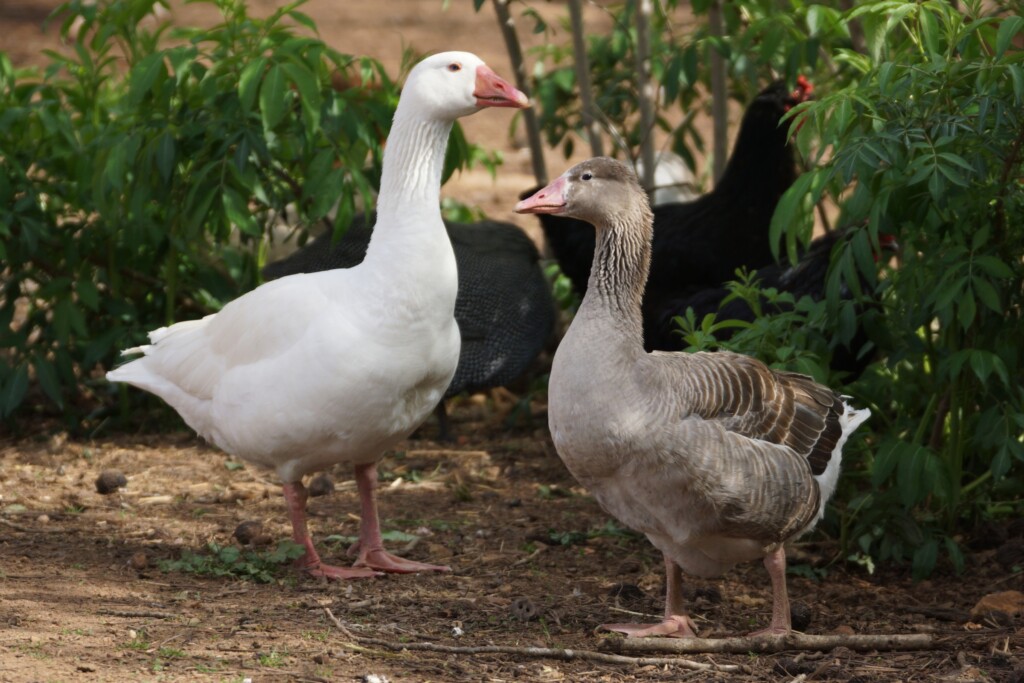
Czech Goose
The Czech goose is a hardy, landrace-style breed that originated in the Czech Republic and is well adapted to the cold and variable weather of Central Europe. This light-to-medium-weight breed is almost always pure white, with a shorter, rounder body than most commercial breeds. It is best known for its excellent foraging ability and self-sufficiency in pasture-based systems.
Czech geese are active, alert birds with high energy and strong instincts. Though not the cuddliest breed, they are intelligent, efficient grazers and do very well with minimal input. Their smaller size also makes them a good option for homesteads with limited space or for mixed-species systems where geese and chickens or ducks forage together.
Laying between 25 and 35 eggs per year, the Czech goose is a respectable layer, and hens often go broody and raise their own young. Their compact size and natural toughness make them ideal for cold climates where resilience and independence are critical traits. Though rare outside of Europe, they’re worth seeking out for sustainable pasture-based flocks.
- Breed Name: Czech
- Breed Type: Egg-laying, light dual-purpose
- Temperament: Active, alert, independent
- Size: Ganders 12–14 lbs, Geese 10–12 lbs
- Eggs Per Year: 25–35
- Egg Size: Medium to large
- Egg Color: White
- Hardiness: Very cold hardy
- Foraging Ability: Excellent
- Lifespan: 12–18 years
- Time to Maturity: 22–26 weeks
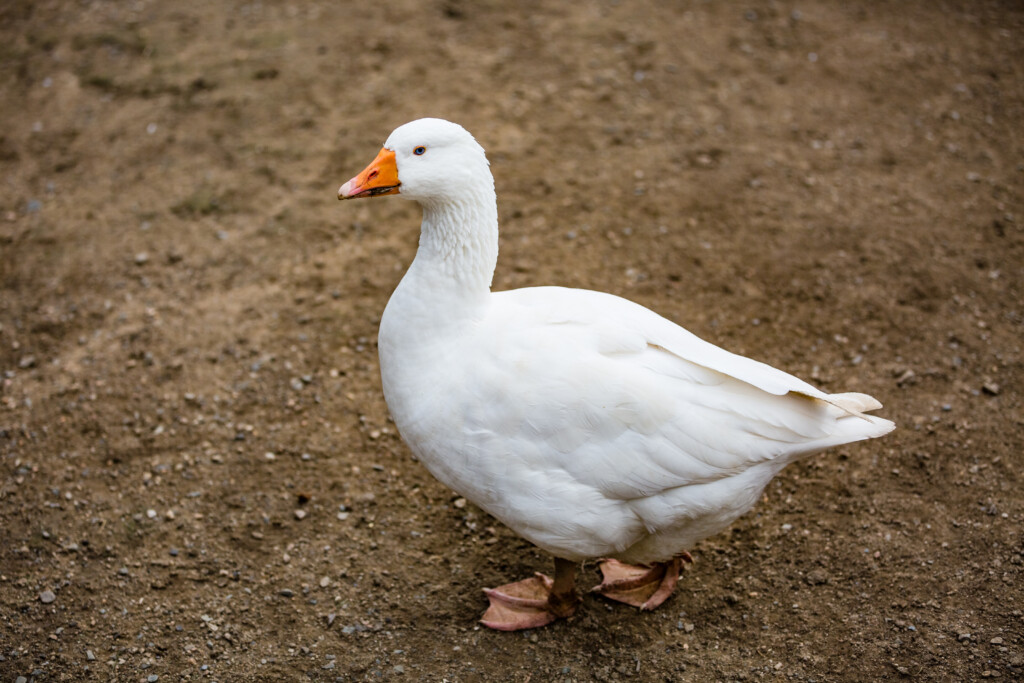
Embden Goose
The Embden goose is the quintessential white farm goose—large, muscular, and fast-growing. It originated in Germany and the Netherlands and was brought to North America in the 19th century. Embdens are now one of the most popular goose breeds for meat production thanks to their impressive size, fast maturity, and excellent carcass yield. Ganders can reach 25 to 30 pounds, making them the heaviest of all domestic geese.
Despite their size, Embdens are generally calm and personable, especially when raised from goslings with regular human interaction. They do well in mixed flocks and are less vocal than Chinese or African geese, making them more suitable for farms with close neighbors. Their white plumage is easy to keep clean in dry pastures, but it can make them more visible to predators in open fields.
Embden geese lay between 20 and 40 large white eggs each spring and may go broody, depending on the individual. Because they grow so rapidly, they’re often butchered at 5 to 6 months of age for tender meat, though older birds provide excellent roasting geese. They do best on pasture but benefit from supplemental grain during rapid growth phases.
- Breed Name: Embden
- Breed Type: Meat, dual-purpose
- Temperament: Calm, strong, manageable
- Size: Ganders 25–30 lbs, Geese 20–25 lbs
- Eggs Per Year: 20–40
- Egg Size: Very large
- Egg Color: White
- Hardiness: Cold hardy
- Foraging Ability: Good
- Lifespan: 15–20 years
- Time to Maturity: 24–30 weeks
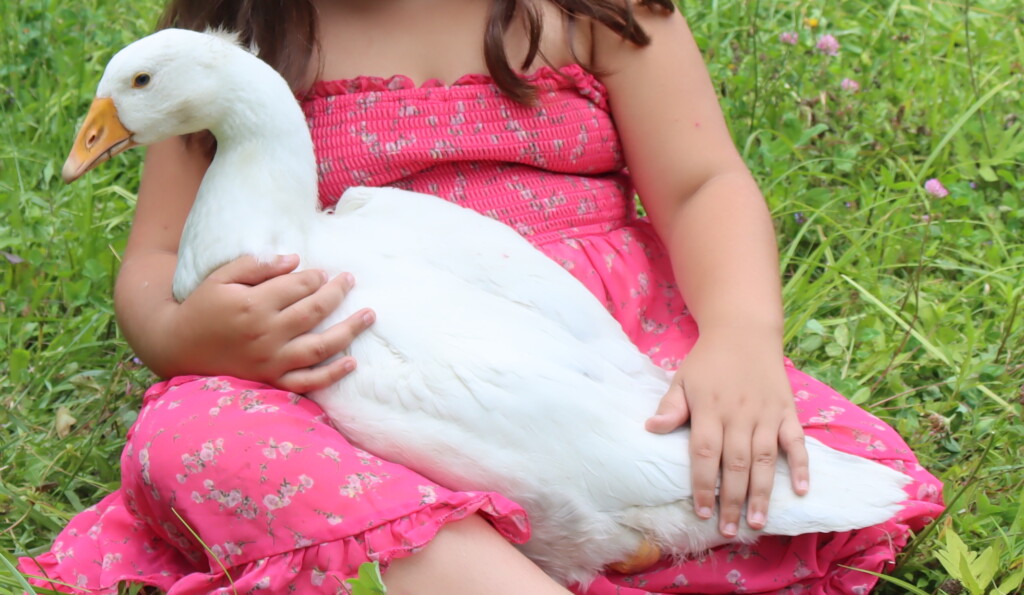
Landes Goose
The Landes goose is a traditional French breed, originally developed in the Landes region of southwestern France. It is best known for its role in foie gras production, thanks to its high natural fat content and ability to be easily fattened. However, outside of foie gras farms, the Landes goose also serves as a high-quality meat bird with excellent flavor and a more moderate size than the heavyweight Toulouse.
Landes geese have a clean, upright carriage, deep gray feathers, and striking white belly contrast. They’re considered to be active and alert, often more energetic than the Dewlap Toulouse but without being flighty or difficult to manage. While they require attentive management if used for fattening, they’re otherwise low-maintenance and capable foragers in grassy paddocks or mixed-use systems.
Egg production is moderate, with hens laying between 20 and 30 white eggs per year. Some hens will go broody and are capable mothers, though many commercial breeders opt for artificial incubation. Though not commonly found in the U.S., the Landes goose is popular in France and parts of Europe for both meat and breeding flocks, and it’s a good option for those interested in traditional French waterfowl breeds.
- Breed Name: Landes
- Breed Type: Meat, foie gras, dual-purpose
- Temperament: Active, alert, calm under good management
- Size: Ganders 18–20 lbs, Geese 16–18 lbs
- Eggs Per Year: 20–30
- Egg Size: Very large
- Egg Color: White
- Hardiness: Cold hardy
- Foraging Ability: Good
- Lifespan: 12–15 years
- Time to Maturity: 24–30 weeks
Normandy Goose
The Normandy goose is another traditional French breed, though it is somewhat less specialized than the Landes. Originating in northern France, this medium-sized breed was historically raised for both eggs and meat on small farms. With gray and white plumage and a well-rounded body, the Normandy goose resembles the production-type Toulouse in appearance but tends to be more active and pasture-oriented.
These geese are sturdy and adaptable, thriving in a variety of weather conditions. They’re good grazers and thrive on pasture with minimal supplemental feed in spring and summer. Normandy geese are also fairly quiet for their size and are often kept in small flocks for their calm demeanor and ease of care. They’re a great match for homesteads looking for self-sufficient, manageable geese.
Hens lay between 25 and 35 large eggs per year, typically in spring, and some will go broody depending on age and conditions. The breed is still commonly found in France but is rarely exported, making it a hidden gem for heritage breed enthusiasts. It’s especially well suited for dual-purpose use in rotational grazing systems.
- Breed Name: Normandy
- Breed Type: Dual-purpose
- Temperament: Calm, pasture-adapted, quiet
- Size: Ganders 16–18 lbs, Geese 14–16 lbs
- Eggs Per Year: 25–35
- Egg Size: Large
- Egg Color: White
- Hardiness: Cold hardy
- Foraging Ability: Excellent
- Lifespan: 12–18 years
- Time to Maturity: 24–28 weeks
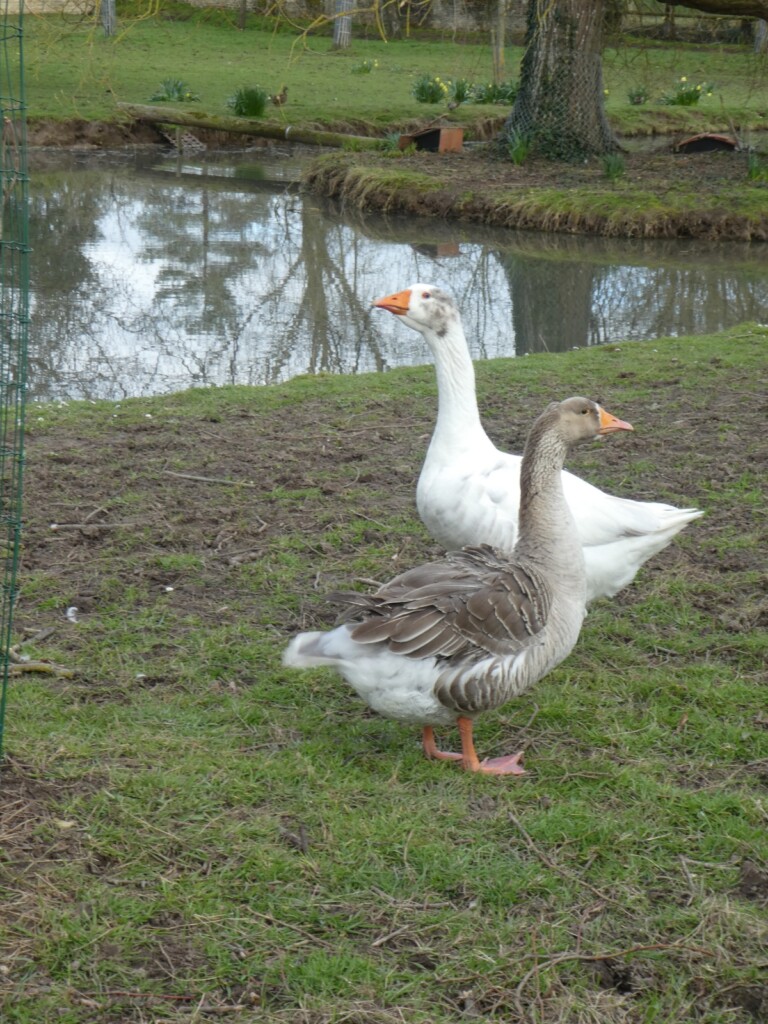
Oland Goose
The Oland goose is a rare, critically endangered Swedish landrace breed originating from the island of Öland. These compact, hardy geese are known for their self-reliance, strong foraging instincts, and ability to thrive in difficult coastal conditions. With white plumage and gray saddleback markings, they resemble a smaller version of the Pomeranian goose but are even more cold- and wind-tolerant.
Oland geese are highly active and independent, best suited for extensive pasture or mixed grazing systems. They do not require heavy feeding and are among the best geese for truly low-input systems. Though they are wary and tend to keep a bit of distance, they are not aggressive, and with early handling they can be quite manageable.
These geese lay around 20 to 30 eggs per year and typically begin nesting early in the spring. Hens often go broody and are excellent mothers, making them ideal for self-sustaining flocks. Because the breed is so rare, it is primarily kept by conservation breeders in Sweden and parts of Northern Europe—but it’s a fantastic candidate for anyone interested in preserving traditional genetics and working breeds.
- Breed Name: Oland
- Breed Type: Heritage, weed control, egg-laying
- Temperament: Hardy, active, independent
- Size: Ganders 10–12 lbs, Geese 8–10 lbs
- Eggs Per Year: 20–30
- Egg Size: Medium
- Egg Color: White
- Hardiness: Extremely cold hardy, wind resistant
- Foraging Ability: Exceptional
- Lifespan: 12–20 years
- Time to Maturity: 20–24 weeks
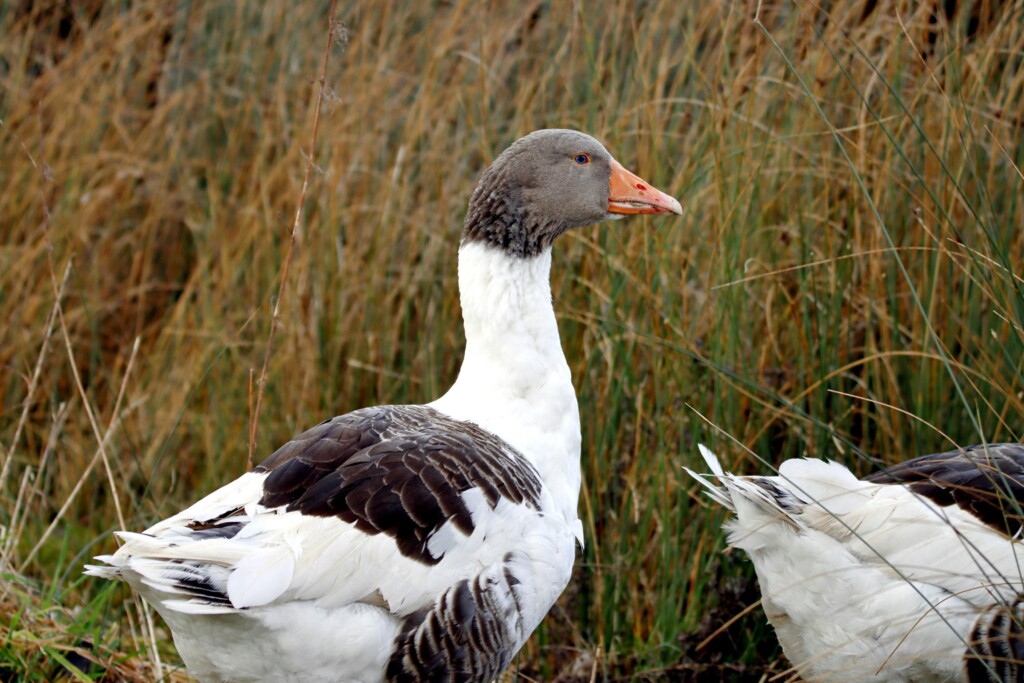
Pilgrim Goose
The Pilgrim goose is a medium-sized, auto-sexing heritage breed developed in the United States in the early 20th century. One of its most distinctive traits is that males are mostly white, while females are gray with white facial markings—allowing you to tell the sexes apart at hatch without vent sexing. This makes managing breeding flocks significantly easier and more beginner-friendly than with most other goose breeds.
Pilgrims are known for their calm, friendly temperament and are often recommended as a great starter breed for small farms and families with children. They’re social and curious birds that can become quite affectionate when handled regularly. They’re also excellent foragers and graze efficiently on pasture, which helps reduce feed costs during the growing season. Pilgrims integrate well with other poultry and aren’t as vocal or territorial as some larger or more assertive breeds.
Though not the heaviest meat producers, Pilgrims still provide a decent table bird, and they’re reliable springtime layers. Hens typically produce 25 to 45 large white eggs per year and are known for being good natural mothers. Their cold hardiness, gentle personality, and auto-sexing traits make them a favorite among heritage breed enthusiasts and homesteaders alike.
- Breed Name: Pilgrim
- Breed Type: Dual-purpose
- Temperament: Friendly, calm, sociable
- Size: Ganders 14–16 lbs, Geese 12–14 lbs
- Eggs Per Year: 25–45
- Egg Size: Large
- Egg Color: White
- Hardiness: Cold hardy
- Foraging Ability: Excellent
- Lifespan: 12–20 years
- Time to Maturity: 24–28 weeks
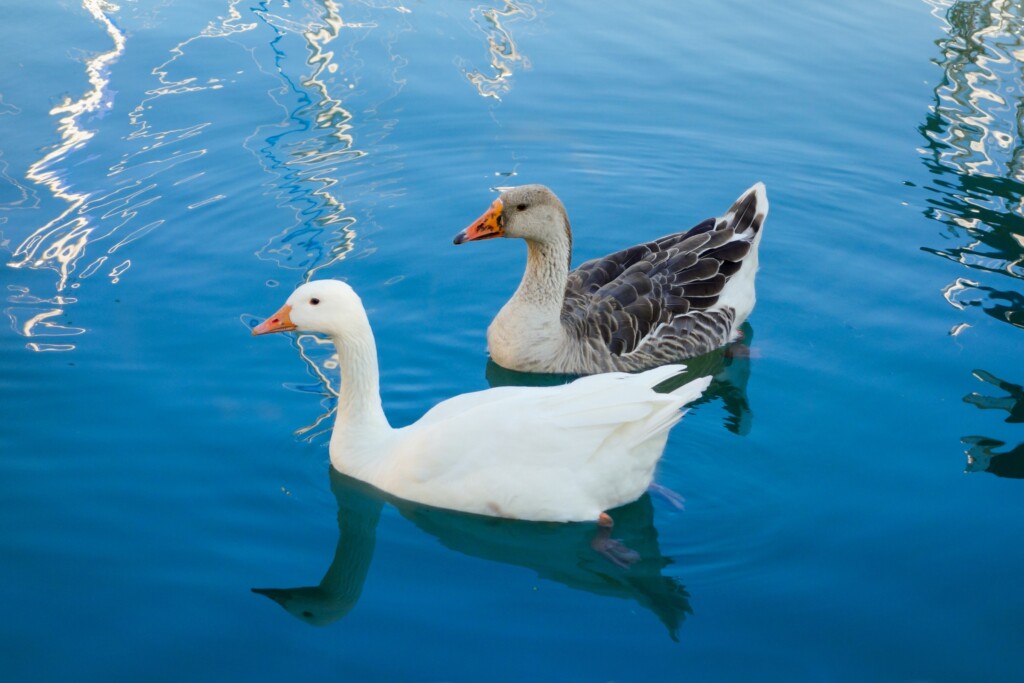
Pomeranian Goose
The Pomeranian goose is an old heritage breed from the Pomerania region of northern Germany and Poland. It’s a medium-to-large goose known for its wide chest, sturdy build, and distinct “saddleback” color pattern—typically gray or buff over a white base. With their striking looks and excellent utility, they were once a common sight on European farms and are now experiencing a revival among small-scale farmers and breed conservationists.
These geese are active and alert foragers, thriving on pasture and often needing little grain during the growing season. Pomeranians are known for their independence and hardiness, and they’re less likely to rely on human interaction than some more docile breeds. They can be somewhat assertive, especially during breeding season, so early handling and socialization are key to raising a manageable flock.
Though primarily valued for meat in their native region, Pomeranian geese are decent egg layers, producing around 20 to 35 eggs per year. Hens are variable in broodiness, but many will sit and raise goslings successfully. Their wide bodies and fast growth rate make them suitable for dual-purpose use, and their unique plumage makes them a standout breed for anyone interested in heritage livestock.
- Breed Name: Pomeranian
- Breed Type: Dual-purpose
- Temperament: Independent, hardy, occasionally assertive
- Size: Ganders 16–18 lbs, Geese 14–16 lbs
- Eggs Per Year: 20–35
- Egg Size: Large
- Egg Color: White
- Hardiness: Very cold hardy
- Foraging Ability: Excellent
- Lifespan: 12–18 years
- Time to Maturity: 24–30 weeks

Roman Goose
The Roman goose is an ancient breed that dates back to the Roman Empire, where it was kept both for food and as a sacred guardian. This small, white goose is easily recognized by the tuft of feathers atop its head, known as a crest or knob, though uncrested Roman geese also exist. Despite their small size, they’re surprisingly effective watchdogs, and their sharp calls can alert the whole farm to unusual activity.
Roman geese are lively and curious, and while they can be noisy, they’re generally not aggressive. Their smaller size makes them easy to handle and well suited to smaller properties or those with limited pasture. They are active foragers and excellent in mixed poultry systems, often cleaning up leftover greens and grasses that others pass over.
Hens lay between 25 and 35 eggs per year, and some will go broody and raise goslings naturally. Romans are one of the few lightweight breeds still valued for both ornamental and utility purposes. They’re also popular in urban or suburban homesteads because of their compact size, clean white feathers, and endearing personalities.
- Breed Name: Roman
- Breed Type: Ornamental, light dual-purpose
- Temperament: Alert, friendly, energetic
- Size: Ganders 10–12 lbs, Geese 8–10 lbs
- Eggs Per Year: 25–35
- Egg Size: Medium to large
- Egg Color: White
- Hardiness: Cold hardy, adaptable
- Foraging Ability: Good
- Lifespan: 10–15 years
- Time to Maturity: 20–24 weeks
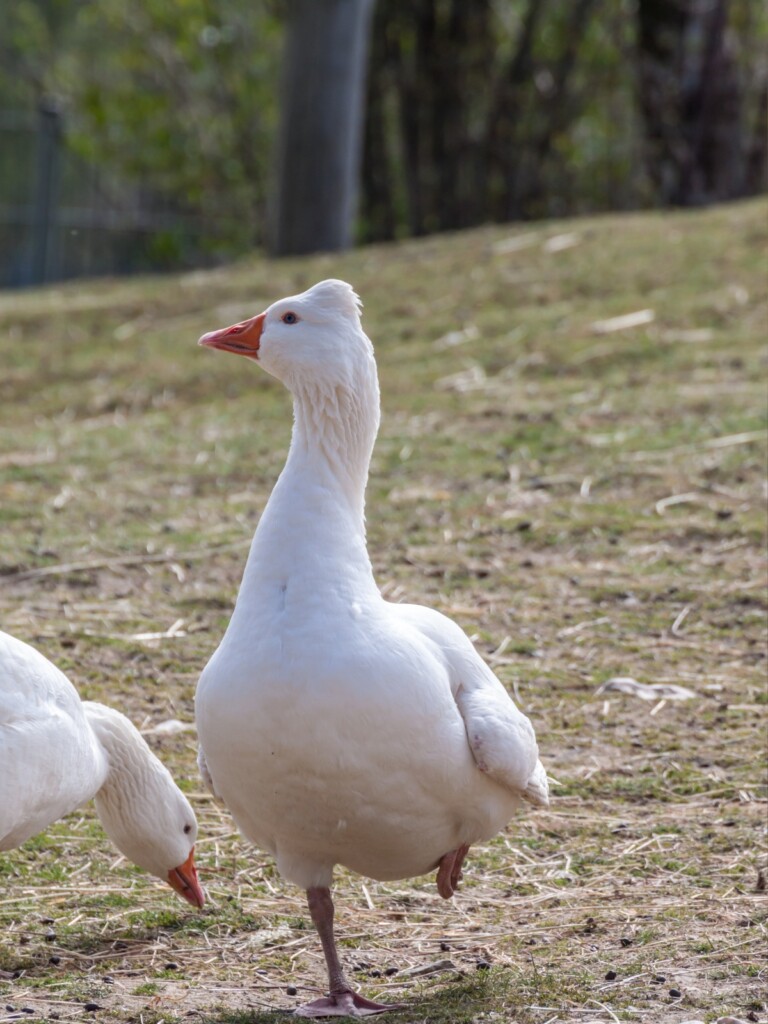
Sebastopol Goose
Sebastopol geese are perhaps the most visually stunning of all domestic geese. They’re known for their long, curly feathers that cascade in waves across their bodies, giving them an ornamental, almost whimsical appearance. Originating in Eastern Europe near the Black Sea, this breed was developed primarily for show, but it also has a gentle temperament that makes it a favorite among backyard keepers and hobby farms.
Despite their ornamental look, Sebastopols are hardy and can thrive in most climates—though their loose feathers are not waterproof, so they need shelter in rainy conditions. Their calm, quiet demeanor makes them easy to handle, and they tend to bond closely with their caretakers. Because their feathers interfere slightly with flight and speed, they are more vulnerable to predators and should be kept in secure enclosures.
Sebastopol geese lay between 20 and 30 eggs per year and are capable mothers, though many breeders prefer to incubate the delicate eggs artificially. Their feathers require some maintenance, especially in wet or muddy weather. Still, for those willing to put in a little extra care, Sebastopols bring elegance and charm to any flock.
- Breed Name: Sebastopol
- Breed Type: Ornamental
- Temperament: Calm, gentle, friendly
- Size: Ganders 12–14 lbs, Geese 10–12 lbs
- Eggs Per Year: 20–30
- Egg Size: Large
- Egg Color: White
- Hardiness: Cold hardy but not waterproof
- Foraging Ability: Moderate
- Lifespan: 12–18 years
- Time to Maturity: 24–28 weeks
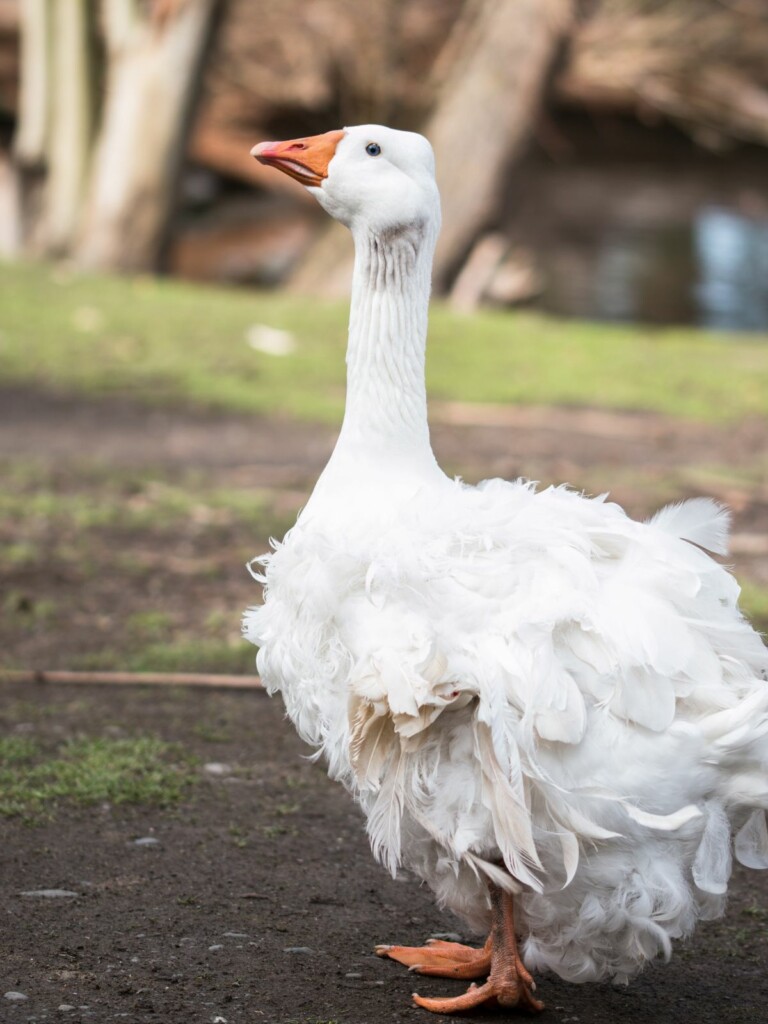
Shetland Goose
The Shetland goose is a small, hardy landrace breed that originated in the Shetland Islands off the northern coast of Scotland. These geese are naturally adapted to cold, wet, and windy conditions, making them one of the most weather-resistant breeds available. With their striking white bodies, gray saddles, and black bills and feet, they are both beautiful and efficient homestead birds.
Shetlands are independent, active foragers who thrive in pasture-based systems. They are excellent weeders and capable of maintaining themselves on grass alone for much of the year. Their small size makes them easy to handle and less demanding in terms of space and feed. While they are not particularly cuddly, they’re intelligent, predator-aware, and easy to manage with minimal fuss.
Hens typically lay 20 to 30 white eggs per year and often go broody. Because the breed is critically endangered, most keepers are dedicated to conservation breeding efforts. If you’re looking for a lightweight, self-sufficient goose that can thrive in tough northern climates, the Shetland goose is a rewarding and practical choice.
- Breed Name: Shetland
- Breed Type: Egg-laying, weed control, heritage
- Temperament: Independent, hardy, low-maintenance
- Size: Ganders 12–14 lbs, Geese 10–12 lbs
- Eggs Per Year: 20–30
- Egg Size: Medium to large
- Egg Color: White
- Hardiness: Extremely cold hardy
- Foraging Ability: Excellent
- Lifespan: 15–20 years
- Time to Maturity: 22–26 weeks
Steinbacher Goose
The Steinbacher goose is a rare heritage breed from Germany, originally developed in the early 20th century. It’s best known for its striking slate-blue or steel-gray plumage and proud, upright carriage. Though originally bred as a fighting goose—a practice no longer permitted—the modern Steinbacher has retained a bold, alert personality and is now valued for its ornamental beauty, excellent foraging ability, and versatility as a light meat bird.
Despite their history, Steinbachers are not aggressive when raised in calm, well-managed environments. They are cautious and observant, with strong flock instincts and a notable capacity for bonding with their keepers. This breed does best in spacious pastures where it can graze and patrol at its own pace. Because they are still relatively rare, Steinbachers are often sought after by breed conservationists and poultry enthusiasts.
Hens lay around 20 to 30 white eggs per year, and while some may go broody, many breeders prefer to incubate the eggs themselves. The breed is highly cold-hardy and does well in European-style management systems with plenty of grass and minimal grain. If you’re looking for an attractive, intelligent, and capable breed, the Steinbacher is an excellent addition to a mixed or specialty flock.
- Breed Name: Steinbacher
- Breed Type: Ornamental, light meat
- Temperament: Alert, self-reliant, intelligent
- Size: Ganders 12–14 lbs, Geese 10–12 lbs
- Eggs Per Year: 20–30
- Egg Size: Large
- Egg Color: White
- Hardiness: Very cold hardy
- Foraging Ability: Excellent
- Lifespan: 12–18 years
- Time to Maturity: 24–28 weeks
Toulouse Goose
The Toulouse goose is a heavyweight French breed prized for its meat, especially foie gras production. There are two main types: the production Toulouse, which is more streamlined and active, and the Dewlap Toulouse, which is heavier with loose skin under the chin and belly, giving it a distinctive appearance. Both types have soft gray feathers and orange bills and legs, but their temperament and care needs differ significantly.
Dewlap Toulouse geese are slower-moving, quieter, and gentler, making them well suited for meat production on larger farms or homesteads with secure pasture and housing. They don’t forage as aggressively as lighter breeds, so they benefit from supplemental grain. Production-type Toulouse geese are more active and capable grazers, better suited for small-scale mixed flocks. Both types are known for their calm, mild personalities and are generally very easy to handle.
These geese lay around 20 to 35 eggs per year, typically starting in late winter or early spring. Some hens will go broody, but not all. Toulouse geese are highly cold-hardy and do well in wet or chilly climates. If you’re looking for a large, gentle bird with good meat potential and a quiet presence, the Toulouse goose is one of the best options available.
- Breed Name: Toulouse
- Breed Type: Meat (heavy), dual-purpose
- Temperament: Calm, gentle, quiet
- Size: Ganders 20–26 lbs, Geese 16–20 lbs (Dewlap strains may be heavier)
- Eggs Per Year: 20–35
- Egg Size: Very large
- Egg Color: White
- Hardiness: Cold hardy, damp climate tolerant
- Foraging Ability: Moderate (low in Dewlap strain)
- Lifespan: 15–20 years
- Time to Maturity: 26–32 weeks
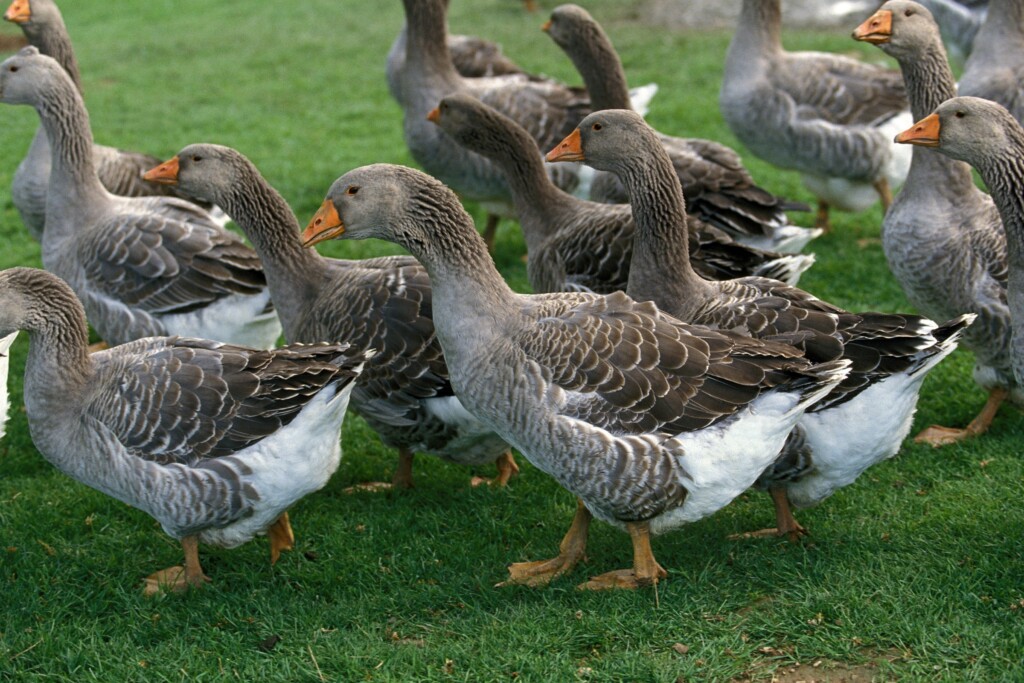
Tufted Buff Goose
The Tufted Buff goose is a unique American ornamental breed developed from the American Buff, with the addition of a genetic tuft of feathers on the crown. It’s a medium-sized goose with soft fawn-colored plumage, a gentle expression, and a compact body. Like the American Buff, it was designed to be a friendly, dual-purpose goose with particular appeal for home flocks, but with an extra eye-catching feature.
Tufted Buffs are calm and docile, with a steady temperament and a tendency to stay close to home. They’re well suited for families, first-time goose keepers, or small properties where ornamental value is appreciated alongside basic productivity. They forage well in pasture but aren’t particularly flighty or energetic, preferring a relaxed pace and gentle environment.
Egg production ranges from 20 to 30 eggs per year, with hens occasionally going broody and successfully raising goslings. Because they are still quite rare, they’re often only available through specialty breeders or waterfowl hatcheries. Their combination of good looks, friendly nature, and practical utility make them a charming addition to any backyard flock.
- Breed Name: Tufted Buff
- Breed Type: Ornamental, dual-purpose
- Temperament: Docile, friendly, easy to manage
- Size: Ganders 16–18 lbs, Geese 14–16 lbs
- Eggs Per Year: 20–30
- Egg Size: Large
- Egg Color: White
- Hardiness: Cold hardy
- Foraging Ability: Good
- Lifespan: 12–18 years
- Time to Maturity: 24–28 weeks
West of England Goose
The West of England goose is a rare British breed developed for utility and ease of management. Like the Pilgrim and Cotton Patch geese, it is auto-sexing: males are mostly white, and females are gray or saddleback-patterned, which makes breeding flocks easy to manage from hatch. This trait, combined with their calm temperament and respectable productivity, has made them a favorite among traditional British smallholders.
This breed is medium-sized and well-suited to foraging on pasture, especially in cool, wet climates. They are quieter than some continental breeds and generally easy to handle, even in the breeding season. While not as widely available as other auto-sexing geese, the West of England goose is gaining attention in conservation and heritage breed circles.
Hens typically lay 20 to 30 large white eggs per year and are often excellent broody mothers. With reliable fertility, good temperament, and low-maintenance care needs, they’re an excellent option for anyone interested in heritage goose keeping or closed-flock breeding programs. Their rarity outside the UK makes them difficult to find, but well worth the effort.
- Breed Name: West of England
- Breed Type: Dual-purpose, auto-sexing
- Temperament: Calm, manageable, easy to handle
- Size: Ganders 16–18 lbs, Geese 14–16 lbs
- Eggs Per Year: 20–30
- Egg Size: Large
- Egg Color: White
- Hardiness: Cold hardy, damp-climate adapted
- Foraging Ability: Very good
- Lifespan: 12–15 years
- Time to Maturity: 24–28 weeks
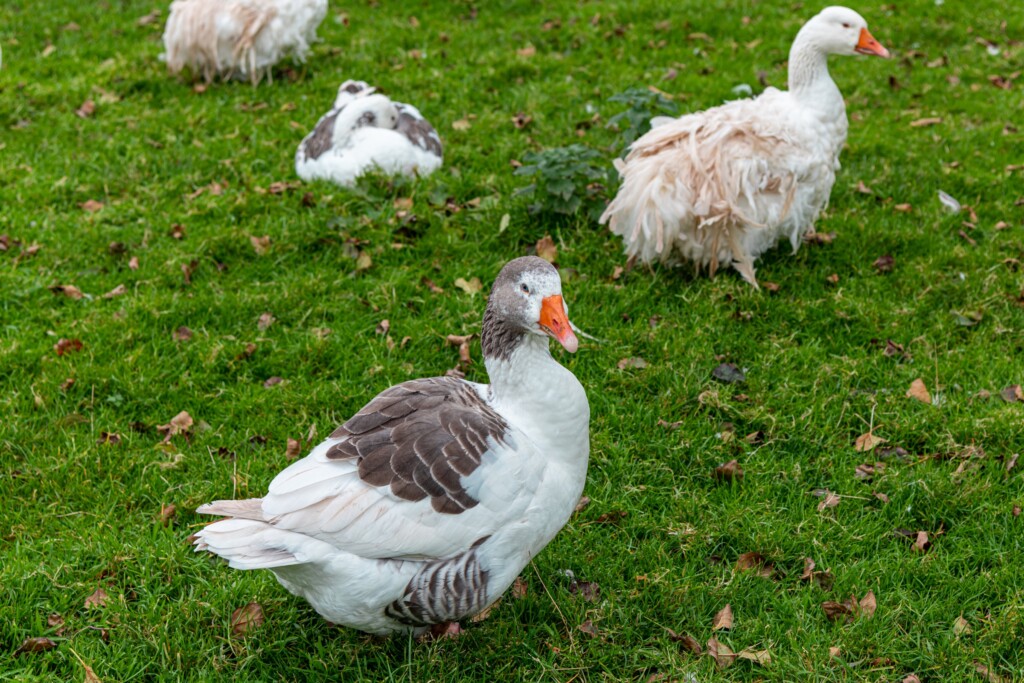
Whether you’re looking for a calm backyard companion, a productive meat goose, or a heritage breed to help preserve rare genetics, there’s a goose breed out there to match your needs.
From heavyweights like the Embden and Toulouse to hardy landrace types like the Shetland and Oland, this list covers the full range of possibilities. With the right breed and setup, raising geese can be a rewarding and low-maintenance addition to any homestead.
